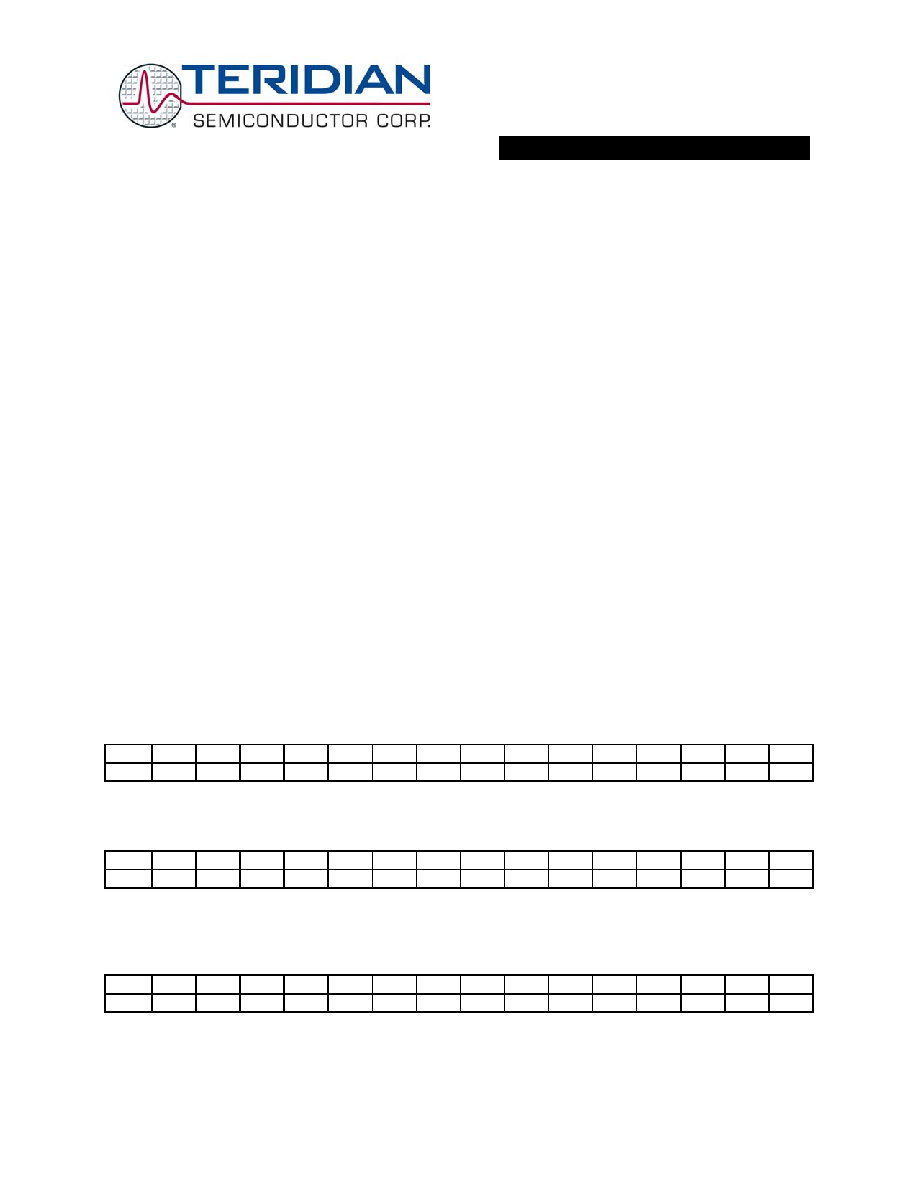- 您現在的位置:買賣IC網 > PDF目錄68812 > 73M1903C-IM (TERIDIAN SEMICONDUCTOR CORP) SPECIALTY CONSUMER CIRCUIT, QCC32 PDF資料下載
參數資料
| 型號: | 73M1903C-IM |
| 廠商: | TERIDIAN SEMICONDUCTOR CORP |
| 元件分類: | 消費家電 |
| 英文描述: | SPECIALTY CONSUMER CIRCUIT, QCC32 |
| 封裝: | LEAD FREE, QFN-32 |
| 文件頁數: | 43/45頁 |
| 文件大小: | 459K |
| 代理商: | 73M1903C-IM |
第1頁第2頁第3頁第4頁第5頁第6頁第7頁第8頁第9頁第10頁第11頁第12頁第13頁第14頁第15頁第16頁第17頁第18頁第19頁第20頁第21頁第22頁第23頁第24頁第25頁第26頁第27頁第28頁第29頁第30頁第31頁第32頁第33頁第34頁第35頁第36頁第37頁第38頁第39頁第40頁第41頁第42頁當前第43頁第44頁第45頁

73M1903C
Modem Analog Front End
DATA SHEET
Page: 7 of 45
2005 TERIDIAN Semiconductor Corporation
Rev 3.4
the data/control frames are 32 bits. The first 16 bits go to the first device; the next 16 bits go to the
second device in the chain, as timed by FSBD of the first device. For four daisy-chained devices, the
data/control frames are 64 bits. The first 16 bits go to the first device in the chain; the next 16 bits go to
the second device in the chain as started by FSBD of the first device, etc. FSBD is always a “Late Type”
frame sync.
Up to eight 73M1903C devices may be daisy-chained if the control frame sync is placed at the middle of
the data frame sync interval. Four devices may be daisy-chained if the control frame sync is placed at the
1/4 of the data frame sync interval. In all cases involving slave and daisy-chain operation, only hardware
controlled Control Frames can be supported (Register 01h bit 0=1). Software requested control frames
are not allowed.
In slave mode the relationship of Fs and Fsclk is Fsclk/Fs, with a range of from 96 to 256 SCLKs per
FS.
Again, the host controls the relationship of
FS to SCLK, with the condition that Fsclk>750KHz and
Fsys=4608*Fs. The 79M1903C PLL must be programmed to generate Fsys with those conditions. To
program the 73M1903C NCOs, OSCIN (Fsclk)=SCLK=Fref when Pdvsr=1 and Prst=0 in the calculations.
Fsys in the previous discussion is Fvco in the calculations which is equal to 4608*Fs. For example, two
typical cases are Fsclk=256*Fs and Fsclk=144*Fs.
For the case when Fsclk=256*Fs and Fs=8KHz, the 79M1903C PLL has to be set to
Fsys=4608*Fs=36.864MHz, and Sclk=256*8KHZ=2.048MHz. Therefore Ndvsr=36.864/2.048=18 (12h)
and Nrst=0
For the case when Fsclk=144*Fs an d Fs=8KHz, the 79M1903C PLL has to be set to
Fsys=4608*Fs=36.864MHz and Sclk=144*8KHZ=1.152MHz. Therefore Ndvsr=36.864/1.152=32 (20h)
and Nrst=0
SERIAL DATA AND CONTROL
The bits transmitted on the SDOUT pin are defined as follows:
bit15 bit14 bit13 bit12 bit11 bit10 bit9
bit8
bit7
bit6
bit5
bit4
bit3
bit2
bit1
bit0
RX15 RX14 RX13 RX12 RX11 RX10 RX9 RX8 RX7 RX6 RX5 RX4 RX3 RX2 RX1 RX0
If the Hardware Control bit (bit 0 of register 01h) is set to zero, the 16 bits that are received on the SDIN
are defined as follows:
bit15 bit14 bit13 bit12 bit11 bit10 bit9
bit8
bit7
bit6
bit5
bit4
bit3
bit2
bit1
bit0
TX15 TX14 TX13 TX12 TX11 TX10 TX9 TX8 TX7 TX6 TX5 TX4 TX3 TX2 TX1 CTL
In this case TX0=0 is forced.
If the Hardware Control bit (bit 0 of register 01h) is set to one, the 16 bits that are received on the SDIN
input are defined as follows:
bit15 bit14 bit13 bit12 bit11 bit10 bit9
bit8
bit7
bit6
bit5
bit4
bit3
bit2
bit1
bit0
TX15 TX14 TX13 TX12 TX11 TX10 TX9 TX8 TX7 TX6 TX5 TX4 TX3 TX2 TX1 TX0
Bit 15 is transmitted/received first. Bits RX15:0 are the receive code word. Bits TX15:0 are the transmit
code word. If the hardware control bit is set to one, a control frame is initiated between every pair of data
frames. If the hardware control bit is set to zero, CTL is used by software to request a control frame. If
相關PDF資料 |
PDF描述 |
|---|---|
| 73M1903C-IM | SPECIALTY CONSUMER CIRCUIT, QCC32 |
| 73S1209F-44IM/F | POWER SUPPLY MANAGEMENT CKT, QCC44 |
| 73S1209F-68IM/F | POWER SUPPLY MANAGEMENT CKT, QCC68 |
| 73S1209F-68IMR/F | POWER SUPPLY MANAGEMENT CKT, QCC68 |
| 73S1209F-44IMR/F | POWER SUPPLY MANAGEMENT CKT, QCC44 |
相關代理商/技術參數 |
參數描述 |
|---|---|
| 73M1903C-IM/F | 功能描述:電信線路管理 IC Modem Analog Front End RoHS:否 制造商:STMicroelectronics 產品:PHY 接口類型:UART 電源電壓-最大:18 V 電源電壓-最小:8 V 電源電流:30 mA 最大工作溫度:+ 85 C 最小工作溫度:- 40 C 安裝風格:SMD/SMT 封裝 / 箱體:VFQFPN-48 封裝:Tray |
| 73M1903C-IM/F1 | 功能描述:電信線路管理 IC RoHS:否 制造商:STMicroelectronics 產品:PHY 接口類型:UART 電源電壓-最大:18 V 電源電壓-最小:8 V 電源電流:30 mA 最大工作溫度:+ 85 C 最小工作溫度:- 40 C 安裝風格:SMD/SMT 封裝 / 箱體:VFQFPN-48 封裝:Tray |
| 73M1903C-IMR/F | 功能描述:電信線路管理 IC Modem Analog Front End RoHS:否 制造商:STMicroelectronics 產品:PHY 接口類型:UART 電源電壓-最大:18 V 電源電壓-最小:8 V 電源電流:30 mA 最大工作溫度:+ 85 C 最小工作溫度:- 40 C 安裝風格:SMD/SMT 封裝 / 箱體:VFQFPN-48 封裝:Tray |
| 73M1903C-IMR/F1 | 功能描述:電信線路管理 IC RoHS:否 制造商:STMicroelectronics 產品:PHY 接口類型:UART 電源電壓-最大:18 V 電源電壓-最小:8 V 電源電流:30 mA 最大工作溫度:+ 85 C 最小工作溫度:- 40 C 安裝風格:SMD/SMT 封裝 / 箱體:VFQFPN-48 封裝:Tray |
| 73M1903-EVM-600 | 功能描述:網絡開發工具 73M1903 w/Ppu & 600 Ohm Term-Usa & Japan RoHS:否 制造商:Rabbit Semiconductor 產品:Development Kits 類型:Ethernet to Wi-Fi Bridges 工具用于評估:RCM6600W 數據速率:20 Mbps, 40 Mbps 接口類型:802.11 b/g, Ethernet 工作電源電壓:3.3 V |
發布緊急采購,3分鐘左右您將得到回復。